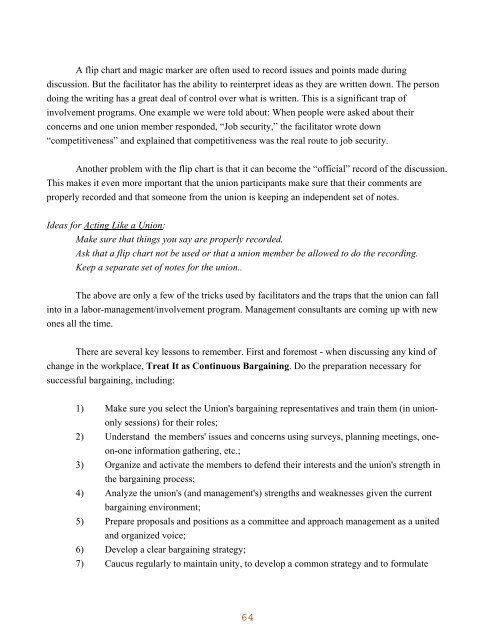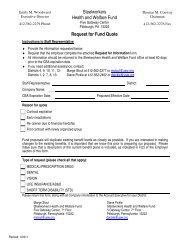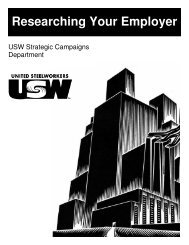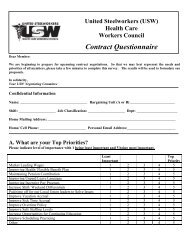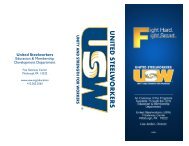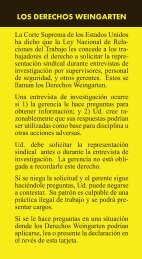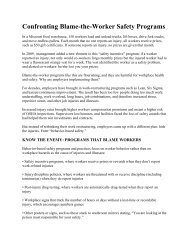Union Approach to Health and Safety: - United Steelworkers
Union Approach to Health and Safety: - United Steelworkers
Union Approach to Health and Safety: - United Steelworkers
You also want an ePaper? Increase the reach of your titles
YUMPU automatically turns print PDFs into web optimized ePapers that Google loves.
A flip chart <strong>and</strong> magic marker are often used <strong>to</strong> record issues <strong>and</strong> points made during<br />
discussion. But the facilita<strong>to</strong>r has the ability <strong>to</strong> reinterpret ideas as they are written down. The person<br />
doing the writing has a great deal of control over what is written. This is a significant trap of<br />
involvement programs. One example we were <strong>to</strong>ld about: When people were asked about their<br />
concerns <strong>and</strong> one union member responded, “Job security,” the facilita<strong>to</strong>r wrote down<br />
“competitiveness” <strong>and</strong> explained that competitiveness was the real route <strong>to</strong> job security.<br />
Another problem with the flip chart is that it can become the “official” record of the discussion.<br />
This makes it even more important that the union participants make sure that their comments are<br />
properly recorded <strong>and</strong> that someone from the union is keeping an independent set of notes.<br />
Ideas for Acting Like a <strong>Union</strong>:<br />
Make sure that things you say are properly recorded.<br />
Ask that a flip chart not be used or that a union member be allowed <strong>to</strong> do the recording.<br />
Keep a separate set of notes for the union..<br />
The above are only a few of the tricks used by facilita<strong>to</strong>rs <strong>and</strong> the traps that the union can fall<br />
in<strong>to</strong> in a labor-management/involvement program. Management consultants are coming up with new<br />
ones all the time.<br />
There are several key lessons <strong>to</strong> remember. First <strong>and</strong> foremost - when discussing any kind of<br />
change in the workplace, Treat It as Continuous Bargaining. Do the preparation necessary for<br />
successful bargaining, including:<br />
1) Make sure you select the <strong>Union</strong>'s bargaining representatives <strong>and</strong> train them (in uniononly<br />
sessions) for their roles;<br />
2) Underst<strong>and</strong> the members' issues <strong>and</strong> concerns using surveys, planning meetings, oneon-one<br />
information gathering, etc.;<br />
3) Organize <strong>and</strong> activate the members <strong>to</strong> defend their interests <strong>and</strong> the union's strength in<br />
the bargaining process;<br />
4) Analyze the union's (<strong>and</strong> management's) strengths <strong>and</strong> weaknesses given the current<br />
bargaining environment;<br />
5) Prepare proposals <strong>and</strong> positions as a committee <strong>and</strong> approach management as a united<br />
<strong>and</strong> organized voice;<br />
6) Develop a clear bargaining strategy;<br />
7) Caucus regularly <strong>to</strong> maintain unity, <strong>to</strong> develop a common strategy <strong>and</strong> <strong>to</strong> formulate


